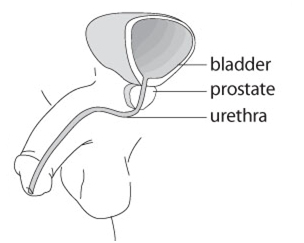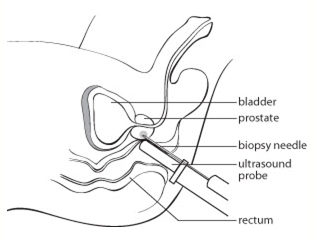
The prostate is a small gland, normally the size of a chestnut, located below the bladder and surrounding the urinary passage (urethra). Its function is to secrete part of the semen produced at ejaculation.
Prostate cancer normally grows slowly until it becomes detectable by finger examination of the prostate — digital rectal examination (DRE)— or by an abnormal blood test reading of the prostate specific antigen (PSA) level.
The abnormality found at DRE or the elevation in PSA level may be due to a prostatic problem other than cancer, such as infection or non-cancerous prostatic enlargement.
Transrectal ultrasound (TRUS) examination involves passing a probe through the anus into the rectum, much like a DRE. Prostate ultrasound imaging allows the examiner to measure the prostate size and assess its texture. Biopsies (tissue samples) are obtained using a spring-loaded device that fires a thin needle into the prostate through the lining of the rectum. Although you will be aware of the biopsy procedure, there is generally not any significant pain. Normally, six or more biopsies are obtained systematically from different locations within the prostate.
The tissue removed at biopsy is preserved and, within a few days, a pathologist will examine it under a microscope to determine if prostate cancer is present. This report should be available within a few weeks.

One should not take aspirin, blood thinners or anti-inflammatory drugs for one week prior to the biopsy procedure, as these medications may increase the risk of bleeding. These medications can usually be restarted a day or two after your examination, unless urinary bleeding persists.
Antibiotic drugs are often prescribed to prevent infection after the biopsies. We as a urologist will carry out the examination. The patient will be asked to lie on the side on a stretcher, after which the examiner will examine the prostate with a finger. The ultrasound probe will then be introduced through the anus into the rectum to record images of the prostate before the biopsies are performed. The entire examination takes about 15 minutes.

It is not unusual to see a bit of blood in the urine and stool for a day or two after prostate biopsies. It is possible to detect blood in the semen for several weeks. When preventive antibiotics are taken properly for the prostate biopsies, infection is very unusual.